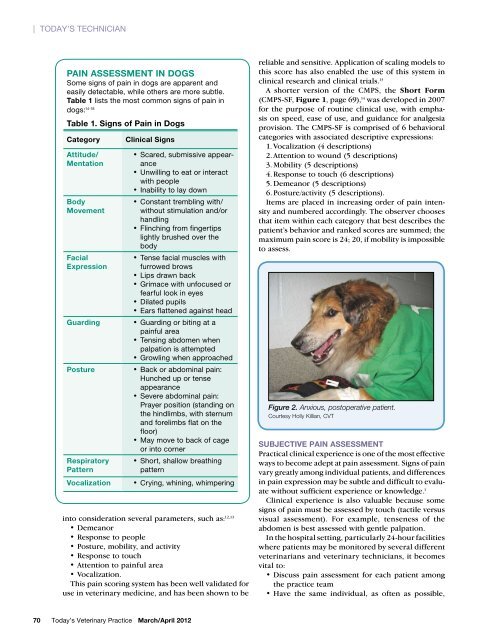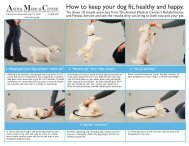Physical Physical - Tripawds Downloads
Physical Physical - Tripawds Downloads
Physical Physical - Tripawds Downloads
- No tags were found...
You also want an ePaper? Increase the reach of your titles
YUMPU automatically turns print PDFs into web optimized ePapers that Google loves.
| Today’s TechnicianPAin AssessMent in DoGssome signs of pain in dogs are apparent andeasily detectable, while others are more subtle.table 1 lists the most common signs of pain indogs: 14-18table 1. signs of Pain in DogsCategoryAttitude/MentationBodyMovementfacialexpressionGuardingPostureRespiratoryPatternvocalizationClinical signs• scared, submissive appearance• Unwilling to eat or interactwith people• inability to lay down• constant trembling with/without stimulation and/orhandling• Flinching from fingertipslightly brushed over thebody• Tense facial muscles withfurrowed brows• Lips drawn back• Grimace with unfocused orfearful look in eyes• dilated pupils• ears flattened against head• Guarding or biting at apainful area• Tensing abdomen whenpalpation is attempted• Growling when approached• Back or abdominal pain:hunched up or tenseappearance• severe abdominal pain:Prayer position (standing onthe hindlimbs, with sternumand forelimbs flat on thefloor)• May move to back of cageor into corner• short, shallow breathingpattern• crying, whining, whimperinginto consideration several parameters, such as: 12,13• Demeanor• Response to people• Posture, mobility, and activity• Response to touch• Attention to painful area• Vocalization.This pain scoring system has been well validated foruse in veterinary medicine, and has been shown to bereliable and sensitive. Application of scaling models tothis score has also enabled the use of this system inclinical research and clinical trials. 13A shorter version of the CMPS, the Short Form(CMPS-SF, Figure 1, page 69), 14 was developed in 2007for the purpose of routine clinical use, with emphasison speed, ease of use, and guidance for analgesiaprovision. The CMPS-SF is comprised of 6 behavioralcategories with associated descriptive expressions:1. Vocalization (4 descriptions)2. Attention to wound (5 descriptions)3. Mobility (5 descriptions)4. Response to touch (6 descriptions)5. Demeanor (5 descriptions)6. Posture/activity (5 descriptions).Items are placed in increasing order of pain intensityand numbered accordingly. The observer choosesthat item within each category that best describes thepatient’s behavior and ranked scores are summed; themaximum pain score is 24; 20, if mobility is impossibleto assess.Figure 2. Anxious, postoperative patient.Courtesy Holly Killian, CvTsuBjeCtive PAin AssessMentPractical clinical experience is one of the most effectiveways to become adept at pain assessment. Signs of painvary greatly among individual patients, and differencesin pain expression may be subtle and difficult to evaluatewithout sufficient experience or knowledge. 1Clinical experience is also valuable because somesigns of pain must be assessed by touch (tactile versusvisual assessment). For example, tenseness of theabdomen is best assessed with gentle palpation.In the hospital setting, particularly 24-hour facilitieswhere patients may be monitored by several differentveterinarians and veterinary technicians, it becomesvital to:• Discuss pain assessment for each patient amongthe practice team• Have the same individual, as often as possible,70Today’s Veterinary Practice March/April 2012






